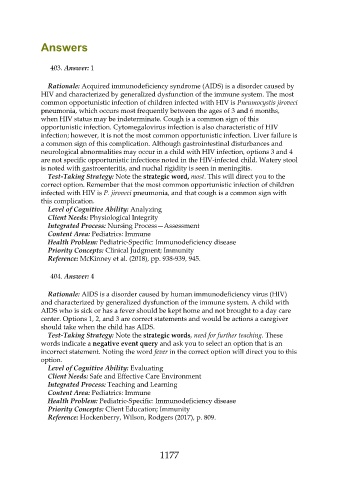Page 1177 - Saunders Comprehensive Review For NCLEX-RN
P. 1177
Answers
403. Answer: 1
Rationale: Acquired immunodeficiency syndrome (AIDS) is a disorder caused by
HIV and characterized by generalized dysfunction of the immune system. The most
common opportunistic infection of children infected with HIV is Pneumocystis jiroveci
pneumonia, which occurs most frequently between the ages of 3 and 6 months,
when HIV status may be indeterminate. Cough is a common sign of this
opportunistic infection. Cytomegalovirus infection is also characteristic of HIV
infection; however, it is not the most common opportunistic infection. Liver failure is
a common sign of this complication. Although gastrointestinal disturbances and
neurological abnormalities may occur in a child with HIV infection, options 3 and 4
are not specific opportunistic infections noted in the HIV-infected child. Watery stool
is noted with gastroenteritis, and nuchal rigidity is seen in meningitis.
Test-Taking Strategy: Note the strategic word, most. This will direct you to the
correct option. Remember that the most common opportunistic infection of children
infected with HIV is P. jiroveci pneumonia, and that cough is a common sign with
this complication.
Level of Cognitive Ability: Analyzing
Client Needs: Physiological Integrity
Integrated Process: Nursing Process—Assessment
Content Area: Pediatrics: Immune
Health Problem: Pediatric-Specific: Immunodeficiency disease
Priority Concepts: Clinical Judgment; Immunity
Reference: McKinney et al. (2018), pp. 938-939, 945.
404. Answer: 4
Rationale: AIDS is a disorder caused by human immunodeficiency virus (HIV)
and characterized by generalized dysfunction of the immune system. A child with
AIDS who is sick or has a fever should be kept home and not brought to a day care
center. Options 1, 2, and 3 are correct statements and would be actions a caregiver
should take when the child has AIDS.
Test-Taking Strategy: Note the strategic words, need for further teaching. These
words indicate a negative event query and ask you to select an option that is an
incorrect statement. Noting the word fever in the correct option will direct you to this
option.
Level of Cognitive Ability: Evaluating
Client Needs: Safe and Effective Care Environment
Integrated Process: Teaching and Learning
Content Area: Pediatrics: Immune
Health Problem: Pediatric-Specific: Immunodeficiency disease
Priority Concepts: Client Education; Immunity
Reference: Hockenberry, Wilson, Rodgers (2017), p. 809.
1177

